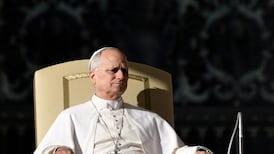Pope John Paul's body was laid in view of the world today and his words resonated across St Peter's Square as faithful mourned the Pole who helped topple Communism in Europe but left a riven Church.
Streams of thousands of pilgrims converged on Rome in a spontaneous outpouring of affection for the Pontiff, who died yesterday evening aged 84 in his Vatican bed after an extended struggle with ill health that slowly sapped his strength.
"Our beloved Holy Father John Paul has returned to the house of the Father," said Archbishop Leonardo Sandri, announcing the death to tens of thousands who had massed under the Pontiff's windows to pray for a miraculous recovery that never came. His dying word was "Amen," newspapers said.
Many countries decreed periods of national mourning, with his native Poland announcing six days and Communist Cuba three. Italy also called three days of mourning. Taoiseach Bertie Ahern said today Ireland would not be observing a day of mourning.
The Pope's body, clad in red and white vestments, was put on view for the world by Vatican television. He lay on a bier under a simple crucifix with his bishop's staff under his arm.
Some 130,000 worshippers gathered at St Peter's Square to hear the Pope's own words read out at a sombre Requiem Mass for the world's best known religious leader, who wielded political influence and kept an iron grip on Church dogma.
John Paul's words resonated through the square when an archbishop read his text prepared for the Sunday after Easter. "It is love which converts hearts and gives peace," the text said. Many wept when the words were read.
News of his death brought tears to faithful in the square and across the globe, triggered a river of tributes and set off what was expected to be one of the greatest influxes of pilgrims in Rome's memory.
His death set in motion elaborate rituals that end one papacy and start the next, and which could last up to a month. His body will be moved to St Peter's Basilica tomorrow for public viewing and will lie in state until his funeral, probably between Wednesday and Friday, where some 200 foreign leaders including President Mary McAleese are expected.
Within 15 to 20 days, the 117 cardinals from around the globe charged with electing the next pope will go behind closed doors in the Vatican's Sistine Chapel. When they make their choice, white smoke will pour from the chapel's chimney.
As day broke over the Polish Pope's adopted twin cities - Rome and Vatican City - the flow of pilgrims from afar began arriving in a fitting tribute to a Pontiff who travelled the equivalent of 30 times the circumference of the earth.
In St Peter's Square, tearful worshippers sang Gregorian chants in the open-air mass presided over by two church leaders considered potential successors, or "papabili" - Cardinal Angelo Sodano of Italy and Cardinal Joseph Ratzinger of Germany. From Brazil to the Philippines, South Africa to Germany, Roman Catholics prayed and mourned. Even Afghanistan's puritanical Islamist Taliban movement said some of what the Pope had said was "worth considering".
|
Many red-hatted princes of the Catholic Church had rushed to Rome in recent days to be near the Pope in his dying hours. Others will arrive before the first General Congregation of the Cardinals gathers tomorrow to decide on the funeral details.
There is no favourite candidate to succeed John Paul, with possible choices coming from around the world. The former Archbishop Karol Wojtyla of Krakow was himself a rank outsider when he was elevated to the papacy on October 16th, 1978.
Apart from his battle against communism and quest for global peace, John Paul will be remembered for his unswerving defence of traditional Vatican doctrines. Some Catholics hope the next Pope will be more liberal.
One of the potential successors, Belgian Cardinal Godfried Danneels, said the next pope would face huge ethical challenges as developments in science, technology and culture raise questions over the church's role in modern society.
But John Paul appointed all but two of the cardinals who will elect his successor, thus stacking the odds that his controversial teachings will not be tampered with.








